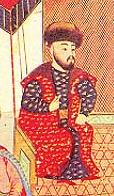|
Ğazı II Giray
Ğazı II Giray Crimean Tatar, Ottoman Turkish and (1554 – November 1607) was Khan of the Crimean Khanate from 1588 to 1596 and again from 1597 until his death in 1607. Born in 1554, he distinguished himself in the Ottoman–Safavid War of 1578–1590, gaining the trust of his Ottoman suzerains. He was appointed khan in 1588, after his homeland experienced a period of political turmoil. He failed to capture Moscow during his 1591 campaign against Russia; however, he managed to secure a favorable peace treaty two years later. He was then summoned to support his Ottoman allies in the Long Turkish War, taking part in multiple military expeditions centered in Hungary. In late 1596, the Ottoman sultan briefly unseated Ğazı II Giray in favor of Fetih I Giray after heeding the advice of Grand Vizier Cığalazade Yusuf Sinan Pasha. He returned to power three months later, continuing his reign until his death in November 1607. Early life Ğazı Giray was born in 1554. Little is know ... [...More Info...] [...Related Items...] OR: [Wikipedia] [Google] [Baidu] [Amazon] |
List Of Crimean Khans
The Crimean Khanate was a state which existed in present-day southern Ukraine from 1441 until 1783. The position of Khan in Crimea was electoral and was picked by beys from four of the most noble families (also known as Qarachi beys: Argyns, Kipchaks, Shirins, and Baryns) at kurultai where the decision about a candidate was adopted.Giray - Khan dynasty of Crimea Khan's Palace website (unavailable currently). The newly elected Khan was raised on a white felt sheet and over him were read Islamic prayers, after that the Khan was triumphantly enthroned. List The following is the chronological table of reigns of Khan (title), Khans of the Crimean Khanate from the Giray dynasty:References < ...
|
